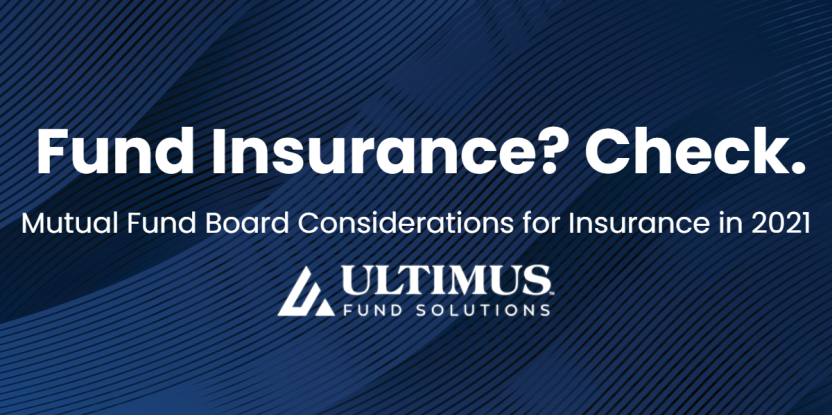With 2021 well underway, fund boards will inevitably meet to consider insurance renewals at some point in the near future. Here are a few items for fund boards to consider and ask about heading into these upcoming renewals:
What’s the market look like?
Since market volatility tends to be a factor in the frequency of claims, the COVID pandemic had a marked effect on securities insurance markets in 2020. Ultimus recently spoke with Konstantine Raftopoulos of Alliant Insurance Services, Inc. (Alliant) to get a broker’s take on the current state of fund Director & Officer (D&O) and adviser Errors & Omissions (E&O) markets. Anecdotal evidence suggests that so far, premium increases of up to 10% are not uncommon for conventional mutual funds and ETFs for the 2021-2022 policy period. Boards of funds with higher perceived risk, including funds with private equity exposures, Business Development Companies, and credit-based funds, could expect higher increases. The recent dismissal with prejudice of the last pending Section 36(b) excessive fee case is also a positive, as that source of many fund D&O claims appears to have subsided, at least for the time being. Insurers are participating in the market and evaluating funds based on their individual risks and merits and homing in on those areas that they deem higher risk. However, the E&O market landscape is a little different. Certain carriers have been cautious about extending coverage into the space in recent years. Publicized incidents in the industry like a $100 million proxy voting error or $400 million financial statement revision serve as expensive recent examples of adviser errors that can potentially give rise to an E&O claim and exhaust a policy.
What are some potential coverage areas the Board should consider asking about?
Scope of Coverage. Have a clear understanding of who and what is being insured by your program. A joint D&O/E&O policy format is common for a proprietary fund family spearheaded by an adviser but uncommon for a multiple series trust given that the board oversees a number of unaffiliated advisers that each maintain separate coverage.
Defense Costs. At the outset, most costs that accrue in the event of a lawsuit are for defense counsel. Boards should consider, in the event of a lawsuit, does the board retain the ability to select its own defense counsel? Does the policy allow for advancing defense costs (meaning, as costs are incurred rather than settling at disposition of the matter)? If the Independent Trustees retain their own counsel, are the costs of Independent Trustee counsel covered as well?
Investigations. Government investigations, federal or state, may be formal or informal. Responding to such investigations can be a costly endeavor requiring counsel and potentially other experts before or regardless of whether a suit is filed. Whether an “investigation” gives rise to what constitutes a “claim” covered under your policy is something for the Board to consider. Boards should be mindful to ask their broker if the definition of “claim” is broad enough to cover reimbursement of costs incurred in responding to informal investigations.
Costs of Corrections Coverage. If the board is considering a joint D&O/E&O policy with its adviser, it should have an understanding of the policy’s cost of corrections coverage, which reimburses an insured for correcting situations that could result in legal liability. This coverage is usually associated with adviser typographical errors, but also applies to any error the adviser may commit as part of its provision of services. Even if not bundled alongside D&O coverage, the board may consider inquiring about it as part of its annual review of an adviser.
Does the Board need separate Cyber Coverage?
Cyber coverage comes in two general flavors: coverage for first-party risks (a breach of the policyholder’s network or systems) and coverage for third-party risks (a breach of a third-party’s network or systems). The board itself is unlikely to face first-party risk exposure as it generally does not have any computer systems or personally identifiable information (PII) of investors under its control. The board’s exposure mainly lies in any claim alleging it failed to supervise the cybersecurity practices of its adviser and vendors. Such a claim should be covered by the board’s primary D&O policy. Separate cyber coverage, if procured, could overlap with the primary D&O policy and cause its own set of issues in determining which policy controls.
The fund’s adviser and service providers are in a different position with respect to E&O coverage. According to Alliant, there has been a noticeable increase in first-party cyber claims by advisers resulting from attempted ransomware attacks. The focus for boards should be understanding whether cyber coverage is a component of their current D&O or D&O/E&O program and on what basis. Boards should also ask whether there are exclusions that could restrict the scope of cybersecurity coverage and whether the policies can be modified to remove any exclusions. Lastly, boards should be familiar with the cyber coverages maintained by their advisers and service providers.
To Side A or Not to Side A?
The question of whether Independent Trustees should consider separate Side A or Independent Director Liability (IDL) coverage may come up. There are generally three main insuring agreements in a D&O policy. Side A covers non-indemnifiable losses (i.e., the fund can’t pay for it (either legally or due to insolvency)), Side B covers reimbursement for indemnifiable claims against the fund (generally the most common), and Side C covers claims against the company/Trust. So even though the fund already has Side A coverage, separate Side A/IDL coverage is a consideration because there are certain conditions under which the Independent Trustees could potentially face personal liability if the primary D&O insurer does not cover and there is no other source of coverage or indemnification. While the potential risk in the mutual fund space is lower relative to an operating company because bankruptcy risk is low for a mutual fund complex, the risk of exposure does exist and there are situations in which Side A “difference in conditions” (DIC) coverage may be needed to kick in and drop down to offer coverage.
Boards should take into consideration their relative asset size as well as the risks associated with the funds they oversee in determining whether supplemental Side A/IDL coverage is appropriate. Boards should also understand that a separate Side A coverage layer is not a substitute for an additional layer of excess D&O coverage, the coverages are different. If pursuing, boards may also want to consider hybrid IDL policies offered by certain insurers that include supplementary Side B coverage. This coverage would cover the fund and take the place of primary Side B coverage in the event that the fund is eligible to be reimbursed for a claim but the insurer has become insolvent, a scenario that became a concern for policyholders following the 2008 financial crisis.
Costs, Costs, Costs
Boards consistently have to evaluate costs and fees of the advisers, service providers, financial intermediaries, and other fund expenses. Insurance is not excluded from that calculus.
In terms of evaluating the cost of insurance, boards will naturally focus on the total dollar figure of the coverage. In a rising cost environment, a board should consider the possibility that proposals may reflect or offer different retention amounts from the current policy and be aware of the implications to the funds in the event of a claim of a higher retention amount. Additionally, though broker commissions are typically pre-negotiated between the broker and the insurer carriers, boards should remain aware that commissions typically range from 10% to 17% of the policy cost. Commission rates are typically lower for primary policies and first excess layers and can escalate across the layer stack as those additional layers are potentially more of an upsell. In reviewing a policy presentation in the boardroom, many insurance brokers have to contend with the fact that insurance premiums have increased in recent years, and so commission dollar amounts have also correspondingly increased. Recognizing the cost pressures funds face, boards shouldn’t be afraid to ask, at a minimum, what steps the broker has taken to attempt to minimize cost increases across carriers and, if warranted, have a frank discussion regarding the overall policy costs inclusive of commissions paid.
A special thanks to Eric Bruhn and Konstantine Raftopoulos of Alliant Insurance Services, Inc. for their market insight and support with the article.




